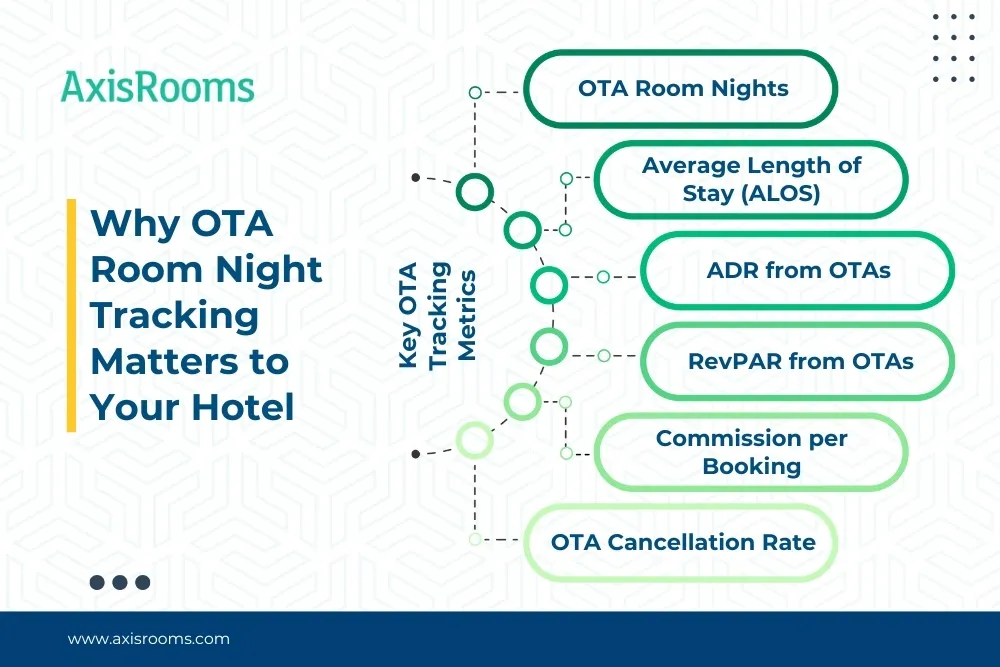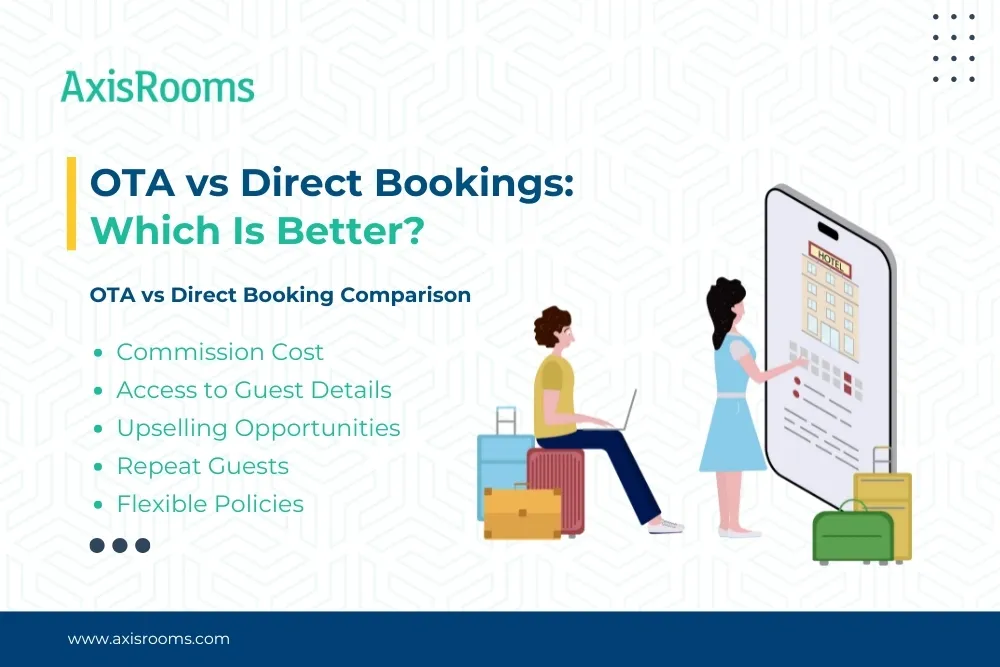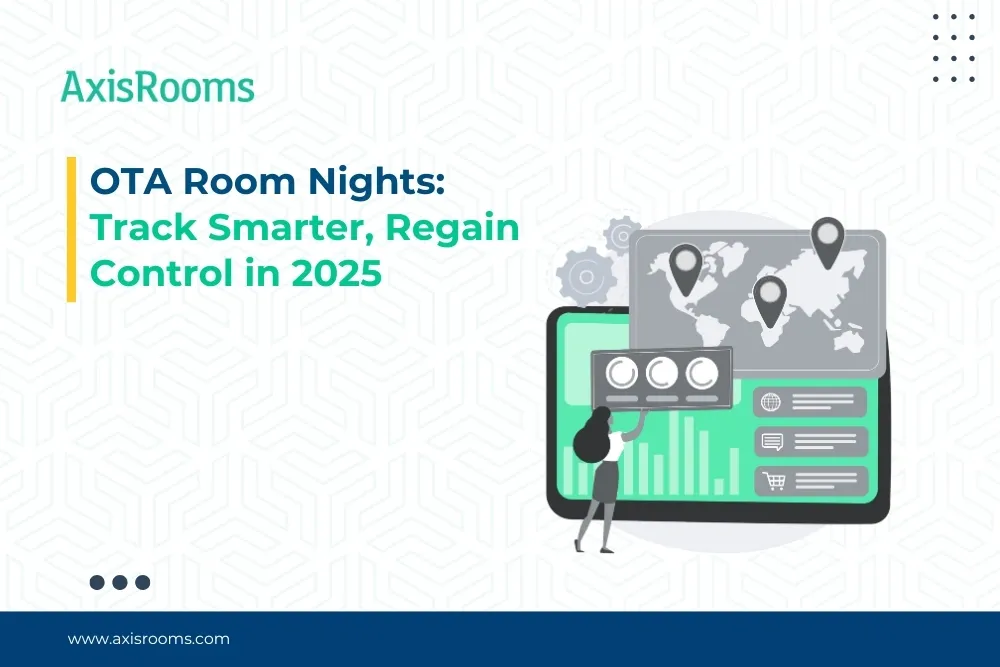Are You Really in Control of Your OTA Bookings?
For most hotels, OTAs (Online Travel Agents) are helpful, but they also come with problems.
They help you get bookings quickly, especially in the off-season. But they also charge high commissions and don’t give you full control over your guest data. Many hotel owners and managers don’t know exactly how many bookings or nights they’re getting from OTAs, or how much they are paying for those.
If you’re only looking at how many bookings you get and not checking room nights and revenue closely, you might be losing money without knowing it.
In this blog, we’ll explain:
- What OTA room nights are
- Why tracking them is important
- Which tools can help you see and control your OTA performance
- How to save on OTA commission and increase your profits
What Are OTA Room Nights?
OTA room nights mean the total number of nights booked through OTAs. For example, if someone books 2 rooms for 3 nights on MakeMyTrip, that’s 6 OTA room nights.
Most hotels count bookings, but not all keep track of how many nights come from each OTA. Tracking this helps you answer important questions:
- Which OTA brings in longer stays?
- Are you making enough money after paying commissions?
- Are repeat guests coming back through OTAs?
If you don’t have this data, it’s hard to make smart pricing and sales decisions.
Why OTA Room Night Tracking Matters to Your Hotel

OTAs are helpful, but only if you keep an eye on how they perform.
If you don’t track OTA room nights:
- You might pay too much in commissions
- You may depend too much on just one or two OTAs
- You may miss the chance to convert OTA guests into direct bookings
Here are the main things you should track and why:
Key OTA Tracking Metrics
If you use this data well, you can build a better hotel revenue strategy.
What Happens If You Don’t Use Tracking Tools
Many small and mid-sized hotels still:
- Log in to different OTA accounts to check bookings
- Collect monthly reports manually
- Don’t know which OTA deal is working well
This creates problems like:
- Overbookings
- Missed high-demand days
- Paying commissions even when profits are low
You can fix all of this with the right tools.
OTA vs Direct Bookings: Which Is Better?

Let’s compare OTA bookings and direct bookings based on what’s better for your hotel:
OTA vs Direct Booking Comparison
OTAs help with visibility, but direct bookings give more profit and guest control.
The Solution: Channel Manager + OTA Tracking Tools
Don’t just count bookings—look at the value they bring. You need tools that show you real-time data.
A Channel Manager connected with your booking system or PMS helps you:
- Track room nights from OTAs in one place
- See how much business each OTA gives you
- Compare direct bookings vs OTA in one report
- Control rates and room availability easily
- Make better plans for discounts and promotions
It works best when your PMS integrations are smooth. Then, your hotel runs better and earns more.
Essential Features in OTA Tracking Tools
You don’t need to be a tech expert. These tools are made to help hotel staff save time and improve results.
Reduce OTA Commission Without Losing Bookings
Here’s how hotels cut down on OTA costs without losing guests:
- Check which OTA costs more: Stop using OTAs that bring low-value bookings.
- Encourage direct bookings: Offer free breakfast or flexible cancellations on your website.
- Follow up with OTA guests: Send emails or messages to book directly next time.
- Talk to your OTA manager: Ask for lower commissions if you give them more volume.
- Use corporate booking tools: If you have GDS or CRS, get more weekday bookings without OTA fees.
You don’t have to remove OTAs—just use them smartly and keep more profit.
AxisRooms Feature Focus: Take Control with OTA Performance Dashboard
It gives you a clear and detailed view of room nights, booking trends, cancellations, and revenue from each OTA. You can compare how OTAs are performing, see which platforms bring short or long stays, and take decisions based on real data—not assumptions.
This dashboard helps GMs, revenue heads, and owners make faster, smarter choices about promotions, inventory allocation, and pricing. And since it integrates with your Channel Manager and PMS, there’s no need to switch between tools or wait for manual reports.
Real Hotel Results After Using These Tools
Hotels using room night tracking tools like AxisRooms or Hotelogix saw:
- 15–20% less commission paid to OTAs
- 25% more direct bookings
- Better room pricing and higher profits on peak days
- Faster decision-making by managers and owners
- Easier revenue planning for the full year
Final Thoughts: Stop Guessing. Start Tracking.
If you don’t track your OTA room nights, you are leaving money on the table.
OTAs are not the problem—but not knowing how they impact your business is. With better tracking and simple tools, even small hotel teams can make big improvements.
The right mix of OTA use, direct bookings, and revenue planning tools can help you grow profitably—and give you full control over your business again.
FAQs OTA Room Nights
Q1-How can I track OTA room nights in real time?
A-Use a Channel Manager linked with your PMS. It shows room nights, revenue, and booking source—all in one place
Q2-How do I reduce OTA commissions?
A-Use data to reduce reliance on high-commission OTAs. Shift repeat guests to book direct and improve your website experience.
Q3-How many OTA bookings should I accept?
A- A 50-50 mix is healthy. Many successful hotels aim for 60% or more direct bookings.


